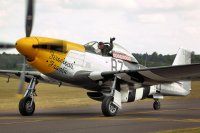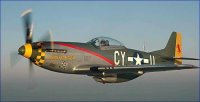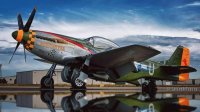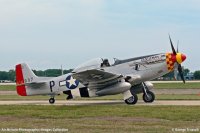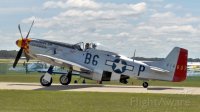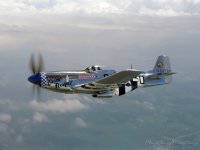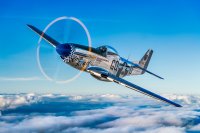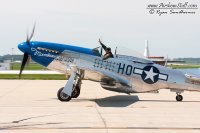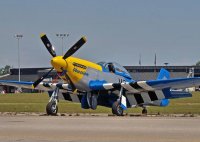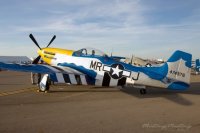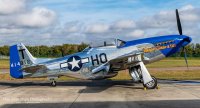Not saying it is right, wrong or otherwise. In all honesty, I am trying to keep things into perspective. I understand this is a warbird and will build heavier than most any other plane of its same size. But taking into consideration, it is basically an enlarged 35% plane. So in perspective, most normal 100cc (35%) planes come in around 26 to 32 pounds. With 32 being on the heavy side. I have seen a few of these Mustangs come in around the 26 pound mark, but not many. Most are in the 32 to 40 pound range. Ok, that being said... I am looking at the construction of the plane and deciding on what I can save in weight where ever I can. For example, the fuse is a good place to start. The 1/8" Balsa sheeting was old stock Bud Nosen. Very dense and extremely heavy.  canned that for lighter less dense wood. How much weight did I save? I have no idea but know it had to be at least a pound or two. Instead of the heavy chunk of 3/4" ply for the firewall/motor mount, I have opted for a much thinner and lighter firewall that will be strategically placed in the motor box. My 100cc Pilot Edge fuse bone dry was around 6 and 3/4 pounds. My 330 was around 8 if I remember right. (40% 122") And the big Yak was 9 and a half if memory serves. Using that as a guide line I tried to keep the fuse to 8 or less pounds. It worked. I remember back when my son and I first started building. We really-REALLY over did things. Way over kill. 1/4x20 "STEEL" bolts for wing bolts. Extra heavy duty hardware. Heavy and I do mean dense heavy balsa and hard wood blocks. We figured that this was the only way to make a plane strong. Not so much. Fast forward, my son now being an ex airframe structural engineer giggles when we talk about how we used to do things. He is the one that has been really giving me some good sound advice on practices and so far it is paying off. So no spread sheet. No mystical graphs or formulas or anything like that. I am just trying to keep things as light as possible and at the same time, using my head and using knowledge of how the full scale planes are built. Example, who knew the ailerons on a KC135 are attached with simple 1/4x20 bolts? I didn't until my son clued me in. Who knows the thickness of the skin on a 747? 0.039in (0.99mm). I used to think that a plane, full scale or rc...got its strength from the structure. Not really so much. Formers give shape, the skin...(balsa sheeting) gives it the strength. So in reality, I am relying solely on overall structure and build practices.
canned that for lighter less dense wood. How much weight did I save? I have no idea but know it had to be at least a pound or two. Instead of the heavy chunk of 3/4" ply for the firewall/motor mount, I have opted for a much thinner and lighter firewall that will be strategically placed in the motor box. My 100cc Pilot Edge fuse bone dry was around 6 and 3/4 pounds. My 330 was around 8 if I remember right. (40% 122") And the big Yak was 9 and a half if memory serves. Using that as a guide line I tried to keep the fuse to 8 or less pounds. It worked. I remember back when my son and I first started building. We really-REALLY over did things. Way over kill. 1/4x20 "STEEL" bolts for wing bolts. Extra heavy duty hardware. Heavy and I do mean dense heavy balsa and hard wood blocks. We figured that this was the only way to make a plane strong. Not so much. Fast forward, my son now being an ex airframe structural engineer giggles when we talk about how we used to do things. He is the one that has been really giving me some good sound advice on practices and so far it is paying off. So no spread sheet. No mystical graphs or formulas or anything like that. I am just trying to keep things as light as possible and at the same time, using my head and using knowledge of how the full scale planes are built. Example, who knew the ailerons on a KC135 are attached with simple 1/4x20 bolts? I didn't until my son clued me in. Who knows the thickness of the skin on a 747? 0.039in (0.99mm). I used to think that a plane, full scale or rc...got its strength from the structure. Not really so much. Formers give shape, the skin...(balsa sheeting) gives it the strength. So in reality, I am relying solely on overall structure and build practices.
The tail group will be built according to plan with one exception. I am going to build the stabs...(or at least try) so that they are removable. So I know there will be extra weight there. How much? I figure I will be adding a pound with the ply ribs and tube and sleeves. I can not see them being heavier than a 40% set of stabs. The 330's were about 1.5 pounds. Dressed, about 2.5 pounds. So the big Stang should be around 2.5 to 3 pounds. Lets say 3.
The wings on the other hand are going to be a challenge. My 40% Sukhoi wings are 4.5 pounds dressed. (servos and such) 330 are also about the same. The big Yak wings are roughly 5 pounds. But they have three servos per side and are "HUGE". So taking into consideration the structure, the extra braces, the three sections...(center, left and right wings), Then add the landing gear. The landing gear on all my other birds range from about a pound and a half to 2.5 pounds. (Not exact-but pretty close guessing) That is with wheels by the way. The gear for the Stang are 5 pounds total. That is including the tail gear and all wheels. By the way, those weights on the wings are each wing panel. The Big Yak being around 10 total. So how much will the Mustang wings weigh? In reality, I am going to count on 14-16 pounds.
Then we have the beast Kolm at 16 pounds. Prop, spinner and hangar assembly, put that to 19 pounds. Next we add electronics. (Servos-wiring-batteries and such) Depending on how elaborate and entailed I get... 9 at the least on servos. 9x2.5 ounces=22.5 ounces. If I do the exras like I want, probably 13 servos. 32.5 ounces. That is just shy of three pounds just for servos. Then we have air cylinders for the vent doors on the fuse. Tubing and air tank for the retracts. Misc. hardware and assorted linkages, horns and arms.
And lets not forget the final fuse construction at around another pound. (Still under 8 pounds)
So here is my mystical formula.
Fuse=8.0
Main wings=16.0
Tail group (fin included) =4.0
Engine and assembly=19
Servos and electronics=7.0
Then we add glassing and paint=4.0
That makes a total of 58 pounds.
I really don't think this is an unrealistic number as Thomas Gass' CARF Mustang came in at about 23.3 kg (51.368 pounds) I would really like to beat that 58 pounds by at least 10 if I can. I suppose if a guy built the plane according to plan and kept it strict, he could build it for around the numbers that Don Smith gives. 39 to 45 pounds. But that is with fixed gear and a 7 pound 95cc single cylinder engine and nothing spectacular built in. Thinking back to the Pitts build, I was projecting a final AUW and actually came pretty close. If not for the heavy 3w 70 twin, I could have made it with weight to spare. I honestly expect the Mustang to come in around 46 to 54 pounds.
Guess we will see what it weighs when I am done.

 canned that for lighter less dense wood. How much weight did I save? I have no idea but know it had to be at least a pound or two. Instead of the heavy chunk of 3/4" ply for the firewall/motor mount, I have opted for a much thinner and lighter firewall that will be strategically placed in the motor box. My 100cc Pilot Edge fuse bone dry was around 6 and 3/4 pounds. My 330 was around 8 if I remember right. (40% 122") And the big Yak was 9 and a half if memory serves. Using that as a guide line I tried to keep the fuse to 8 or less pounds. It worked. I remember back when my son and I first started building. We really-REALLY over did things. Way over kill. 1/4x20 "STEEL" bolts for wing bolts. Extra heavy duty hardware. Heavy and I do mean dense heavy balsa and hard wood blocks. We figured that this was the only way to make a plane strong. Not so much. Fast forward, my son now being an ex airframe structural engineer giggles when we talk about how we used to do things. He is the one that has been really giving me some good sound advice on practices and so far it is paying off. So no spread sheet. No mystical graphs or formulas or anything like that. I am just trying to keep things as light as possible and at the same time, using my head and using knowledge of how the full scale planes are built. Example, who knew the ailerons on a KC135 are attached with simple 1/4x20 bolts? I didn't until my son clued me in. Who knows the thickness of the skin on a 747? 0.039in (0.99mm). I used to think that a plane, full scale or rc...got its strength from the structure. Not really so much. Formers give shape, the skin...(balsa sheeting) gives it the strength. So in reality, I am relying solely on overall structure and build practices.
canned that for lighter less dense wood. How much weight did I save? I have no idea but know it had to be at least a pound or two. Instead of the heavy chunk of 3/4" ply for the firewall/motor mount, I have opted for a much thinner and lighter firewall that will be strategically placed in the motor box. My 100cc Pilot Edge fuse bone dry was around 6 and 3/4 pounds. My 330 was around 8 if I remember right. (40% 122") And the big Yak was 9 and a half if memory serves. Using that as a guide line I tried to keep the fuse to 8 or less pounds. It worked. I remember back when my son and I first started building. We really-REALLY over did things. Way over kill. 1/4x20 "STEEL" bolts for wing bolts. Extra heavy duty hardware. Heavy and I do mean dense heavy balsa and hard wood blocks. We figured that this was the only way to make a plane strong. Not so much. Fast forward, my son now being an ex airframe structural engineer giggles when we talk about how we used to do things. He is the one that has been really giving me some good sound advice on practices and so far it is paying off. So no spread sheet. No mystical graphs or formulas or anything like that. I am just trying to keep things as light as possible and at the same time, using my head and using knowledge of how the full scale planes are built. Example, who knew the ailerons on a KC135 are attached with simple 1/4x20 bolts? I didn't until my son clued me in. Who knows the thickness of the skin on a 747? 0.039in (0.99mm). I used to think that a plane, full scale or rc...got its strength from the structure. Not really so much. Formers give shape, the skin...(balsa sheeting) gives it the strength. So in reality, I am relying solely on overall structure and build practices. 